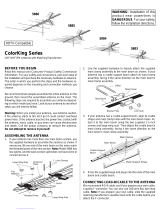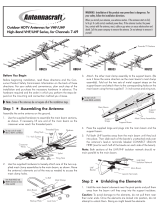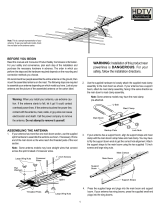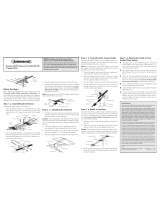Radio Shack U-75R User manual
- Category
- Network antennas
- Type
- User manual
This manual is also suitable for

©
1997, 2000 Tandy Corporation.
All Rights Reserved.
RadioShack and RadioShack.com are trademarks used by Tandy Corporation.
OWNER’S MANUAL — Please read before using this equipment.
U-75R UHF Antenna
BEFORE YOU BEGIN
Before you begin installation, read this manual and the sepa-
rate Consumer Product Safety Commission information sheet.
For your safety and convenience, plan each step of the installa-
tion and purchase the necessary hardware in advance. The
hardware required and the order in which you perform the steps
depend on the mounting and connection method you choose.
Warning: When you install your antenna, use extreme caution.
If the antenna starts to fall, let it go! It could contact overhead
power lines. If the antenna touches the power line, contact with
the antenna, mast, cable, or guy wires can cause electrocution
and death. Call the power company to remove the antenna.
Do
not attempt to remove it yourself.
ASSEMBLING THE ANTENNA
Assemble the entire antenna on the ground.
1. Use the supplied hardware to loosely attach the supplied
mast clamp assembly to the main boom, as shown.
Note: To access the mast clamp holes, move the antenna’s
elements out of the way as needed.
2. Press the supplied large end plugs into the main boom.
CONNECTING LEAD-IN CABLE
TO THE ANTENNA
We recommend RG-6 cable and, if you prepare your own ca-
ble, a quality F-connector. You can also use 300-ohm flat, twin-
lead cable. (RadioShack carries a variety of suitable cables and
connectors.)
Note: If you prepare your own coaxial cable, be sure to slide
the supplied matching transformer’s weather boot onto the ca-
ble before you attach the F-connector.
Using Coaxial Cable
If you plan to add this antenna to a VHF antenna’s mast, refer
to “Adding the UHF Antenna to a VHF Antenna Installation” on
Page 2 for instructions. This type of setup requires twin-lead
cable. See “Using Twin-Lead Cable” to connect the cable to
your antenna. If you are connecting this UHF antenna directly
to your TV, follow these steps to make this connection using
coaxial cable.
1. Thread a matching transformer’s spade terminals through
the antenna’s strain-relief tab. (Matching transformers are
available at your local RadioShack store.)
2. Slide the spade terminals around the antenna’s lead-in ter-
minals (on both sides of the boom), then secure them with
the supplied flat washers and large wing nuts.
3. Screw the cable’s F-connector onto the matching trans-
former.
4. Slip the weather boot over the connection. If you use a
rebuilt cable without a weather boot, cover the connection
with weather-resistant tape.
Using Twin-Lead Cable
To connect flat, twin-lead cable to your antenna:
1. Split one end of the twin-lead cable for a length of about 3
inches. Then strip about
1
/
2
inch of insulation from both
leads.
2. Thread the stripped leads through the antenna’s strain-
relief tab.
U-Bolt
Mast Clamp
Backup Plate
Main Boom
Lock Nuts
Lead-In
Terminals
Weather Boot
F-Connector
Matching
Transformer
Strain-Relief Tab
Flat Washers
Large
Wing Nuts
Spade
Terminals
Main
Boom
Lead-In Terminals
Strain-Relief Tab
Twin-Lead Cable
Flat Washers
Large
Wing Nuts
Main
Boom
15-2160.fm Page 1 Friday, April 28, 2000 5:47 PM

2
3. Wrap each lead around one of the antenna’s lead-in termi-
nals (on both sides of the boom). Be sure there is enough
slack between the strain-relief tab and the antenna termi-
nals to prevent stress on the cable or the terminals.
4. Secure the leads with the supplied flat washers and large
wing nuts.
UNFOLDING THE ANTENNA’S ELEMENTS
1. Hold the main boom’s longer elements near the pivot points
and pull them away from the boom until they snap into the
self-locking plastic support insulators.
Caution:
To avoid damage to the elements, do not pull
them near their outer ends. Once the elements are locked
into position, do not attempt to unlock them. Doing so might
break the self-locking tabs.
2. Hold each wing boom and turn its elements until they snap
squarely into place (perpendicular to the boom).
3. Press the supplied small end plugs into the wing booms.
4. Bolt the triangular wing boom brackets onto the main boom
using the supplied 1
1
/
2
-inch screw and small wing nut, as
shown.
5. Insert the top and bottom wing booms into the wing boom
brackets. Secure them with the four supplied 1
1
/
4
-inch
screws and small wing nuts, as shown.
ATTACHING TO THE MAST
We recommend that you enlist the help of another person be-
fore you put up the mast or attach your antenna to it. How you
set up your mast depends on your specific installation. Refer to
the separate Consumer Product Safety Commission informa-
tion sheet for recommended methods. If you plan to add this
antenna to a VHF antenna’s mast, refer to “Adding the UHF An-
tenna to a VHF Antenna Installation” for instructions.
1. Slide the antenna’s mast clamp assembly over the end of
the mast.
2. Tighten the mast clamp assembly’s lock nuts to hold the
antenna in place. Do not overtighten the lock nuts.
3. Set up the mast, then rotate it so the antenna’s shorter ele-
ments point toward the broadcast antennas of the stations
you want to receive.
ADDING THE UHF ANTENNA TO A VHF
ANTENNA INSTALLATION
To connect your UHF antenna to a VHF antenna, follow these
steps.
1. Loosen the lock nuts on the VHF antenna’s mast clamp
assembly. Slide the VHF antenna down the mast about 70
inches, then tighten the lock nuts to hold the antenna in
place. Do not overtighten the lock nuts.
2. Mount your UHF antenna at the top of the mast. (See
“Attaching to the Mast.”)
3. Use only about 70 inches of twin-lead cable to connect
your UHF antenna to the VHF antenna. Be sure the cable
is long enough to reach from the lead-in terminals of one
antenna to the lead-in terminals of the other. Connect the
cable to your UHF antenna first. (Follow the steps in the
section “Using Twin-Lead Cable” on Page 1.)
4. Split the other end of the twin-lead cable for a length of
about 3 inches. Then strip about
1
/
2
inch of insulation from
both leads.
5. Remove the VHF antenna’s large wing nuts and flat wash-
ers from its lead-in terminals. (If you used coaxial cable to
connect the VHF antenna to your TV, also remove the
spade terminals from the lead-in terminals.)
Wing Boom
Brackets
Main Boom
1
1
/
2
-Inch
Screw
Small Wing Nut
Small Wing Nuts
1
1
/
4
-Inch
Screws
Top Wing Boom
Bottom Wing Boom
Wing Boom
Brackets
Mast
Toward TV
Stations’
Antennas
Main Boom Long Element
Wing Boom Elements
Main Boom
Short Elements
15-2160.fm Page 2 Friday, April 28, 2000 5:47 PM

3
6. Wrap each lead of the twin-lead cable around one of the
VHF antenna’s lead-in terminals (on both sides of the
boom).
7. Replace the spade terminals (if removed in Step 5), flat
washers, and large wing nuts.
Note: In some locations, you might need to use an indoor/out-
door 300-ohm splitter/combiner (available at your local Ra-
dioShack store) to receive a satisfactory picture on your TV.
ROUTING THE CABLE TO YOUR TV/VCR
If you use coaxial cable:
• Use plastic tape or mast standoff insulators to secure the
coaxial cable to the mast at about 3-foot intervals. Continue
down the roof and the side of the house using roof and wall
standoff insulators.
• Use coaxial cable nail-in clips every few feet to secure the
cable between the mast and where the cable enters the
house.
• Use a 75-ohm grounding block at the point where the coax-
ial cable enters the house. Read the Consumer Product
Safety Commission sheet for grounding instructions.
• Use a wall-through lead-in tube (not supplied) to neatly
route the coaxial cable through walls.
If you use twin-lead cable:
• Be sure the twin-lead cable remains at least 4 inches away
from all metal surfaces.
• Use standoff insulators about every 4 feet. Twist the twin-
lead cable about three turns between standoff insulators.
• Read the separate Consumer Product Safety Commission
sheet for grounding instructions.
CONNECTING TO YOUR TV/VCR
Connect the antenna’s lead-in cable to your TV/VCR’s antenna terminals according to the type of cable you used. RadioShack car-
ries a variety of matching transformers, if one of these suits your needs. Below are some sample connections.
Make connections as described if you have:
• Coaxial antenna lead-in
• Twin-lead TV/VCR antenna terminals
Make connections as described if you have:
• Coaxial antenna lead-in
• Coaxial TV/VCR antenna terminal
Large Wing
Nuts
Flat Washers
VHF Antenna’s
Lead-In Terminal
Twin-Lead Cable
to UHF Antenna
RadioShack
Indoor/Outdoor
Matching Transformer
Cat. No. 15-1140
Connect to TV/VCR’s
300-Ohm Screw Terminals
Connect
Coaxial Lead-In
from Antenna
Connect to TV/VCR’s
75-Ohm F-Connector
Coaxial Lead-In
from Antenna
15-2160.fm Page 3 Friday, April 28, 2000 5:47 PM

15-2160
04/00
Printed in the USA
RadioShack
A Division of Tandy Corporation
Fort Worth, Texas 76102
Make connections as described if you have:
• Twin-lead antenna lead-in
• Coaxial TV/VCR antenna terminal
Make connections as described if you have:
• Twin-lead antenna lead-in
• Twin-lead TV/VCR antenna terminals
RadioShack
Matching Transformer
Cat. No. 15-1253
Connect to TV/VCR’s
75-Ohm F-Connector
Connect Twin-Lead
Lead-In from Antenna to
Screw Terminals
Connect to TV/VCR’s
300-Ohm Screw Terminals
Twin-Lead Lead-In
from Antenna
Limited Ninety-Day Warranty
This product is warranted by RadioShack against manufacturing defects in material and workmanship under normal use for ninety (90) days from the date of purchase from Ra-
dioShack company-owned stores and authorized RadioShack franchisees and dealers. EXCEPT AS PROVIDED HEREIN, RadioShack MAKES NO EXPRESS WARRANTIES
AND ANY IMPLIED WARRANTIES, INCLUDING THOSE OF MERCHANTABILITY AND FITNESS FOR A PARTICULAR PURPOSE, ARE LIMITED IN DURATION TO THE DU-
RATION OF THE WRITTEN LIMITED WARRANTIES CONTAINED HEREIN. EXCEPT AS PROVIDED HEREIN, RadioShack SHALL HAVE NO LIABILITY OR RESPONSIBILITY
TO CUSTOMER OR ANY OTHER PERSON OR ENTITY WITH RESPECT TO ANY LIABILITY, LOSS OR DAMAGE CAUSED DIRECTLY OR INDIRECTLY BY USE OR PER-
FORMANCE OF THE PRODUCT OR ARISING OUT OF ANY BREACH OF THIS WARRANTY, INCLUDING, BUT NOT LIMITED TO, ANY DAMAGES RESULTING FROM IN-
CONVENIENCE, LOSS OF TIME, DATA, PROPERTY, REVENUE, OR PROFIT OR ANY INDIRECT, SPECIAL, INCIDENTAL, OR CONSEQUENTIAL DAMAGES, EVEN IF
RadioShack HAS BEEN ADVISED OF THE POSSIBILITY OF SUCH DAMAGES.
Some states do not allow limitations on how long an implied warranty lasts or the exclusion or limitation of incidental or consequential damages, so the above limitations or exclu-
sions may not apply to you.
In the event of a product defect during the warranty period, take the product and the RadioShack sales receipt as proof of purchase date to any RadioShack store. RadioShack
will, at its option, unless otherwise provided by law: (a) correct the defect by product repair without charge for parts and labor; (b) replace the product with one of the same or sim-
ilar design; or (c) refund the purchase price. All replaced parts and products, and products on which a refund is made, become the property of RadioShack. New or reconditioned
parts and products may be used in the performance of warranty service. Repaired or replaced parts and products are warranted for the remainder of the original warranty period.
You will be charged for repair or replacement of the product made after the expiration of the warranty period.
This warranty does not cover: (a) damage or failure caused by or attributable to acts of God, abuse, accident, misuse, improper or abnormal usage, failure to follow instructions,
improper installation or maintenance, alteration, lightning or other incidence of excess voltage or current; (b) any repairs other than those provided by a RadioShack Authorized
Service Facility; (c) consumables such as fuses or batteries; (d) cosmetic damage; (e) transportation, shipping or insurance costs; or (f) costs of product removal, installation, set-
up service adjustment or reinstallation.
This warranty gives you specific legal rights, and you may also have other rights which vary from state to state.
RadioShack Customer Relations, 200 Taylor Street, 6th Floor, Fort Worth, TX 76102
We Service What We Sell
12/99
15-2160.fm Page 4 Friday, April 28, 2000 5:47 PM
-
 1
1
-
 2
2
-
 3
3
-
 4
4
Radio Shack U-75R User manual
- Category
- Network antennas
- Type
- User manual
- This manual is also suitable for
Ask a question and I''ll find the answer in the document
Finding information in a document is now easier with AI
Related papers
-
Radio Shack U-120XR User manual
-
Radio Shack Six-Element Triple-Drive FM Antenna User manual
-
Radio Shack VU-160XR User manual
-
Radio Shack VU-110XR User manual
-
Radio Shack 15-2151 User manual
-
Radio Shack VU-190XR User manual
-
Radio Shack 15-2160 User manual
-
Radio Shack Six-Element Triple-Drive FM Antenna User manual
-
Radio Shack 15-1119A User manual
-
Radio Shack TV ANTENNA Owner's manual
Other documents
-
 Solid Signal ColorKing 5886 Assembly Manual
Solid Signal ColorKing 5886 Assembly Manual
-
Samsung 15-1868 User manual
-
 AntennaCraft HBU22 Assembly Manual
AntennaCraft HBU22 Assembly Manual
-
 AntennaCraft CCS1843 Assembly Instructions
AntennaCraft CCS1843 Assembly Instructions
-
 AntennaCraft C490 Installation guide
AntennaCraft C490 Installation guide
-
Philips US2-PH61112 User manual
-
RCA ANT3036X User manual
-
Winegard YA-1713 Owner's manual
-
Maxview C3006 Operating instructions
-
Winegard HD-7010 User manual







